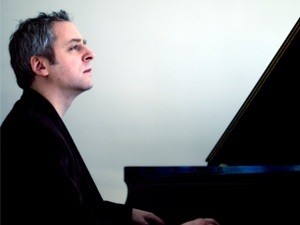|
Back
The Riches From the Rags New York
Isaac Stern Auditorium, Carnegie Hall
04/17/2016 -
Johann Sebastian Bach: English Suite No. 3 in G Minor, BWV 808
William Byrd: My Ladye Nevells Booke: “The Passinge Mesures: the Nynthe Pavian”
William Bolcom: Graceful Ghost Rag
Scott Hayden/Scott Joplin: Sunflower Slow Drag
Paul Hindemith: Suite “1922”, Op. 26: Ragtime
Igor Stravinsky: Piano Rag-Music
Charles Ives: Four Ragtime Dances: Ragtime Dance No. 3 and 4
Conlon Nancarrow: Two Canons for Ursula: Canon No. 1
Richard Wagner: Tannhäuser: “Pilgrim’s Chorus” (arr. Charles Lambert)
Franz Schubert: Piano Sonata in B-flat Major, D. 960
Jeremy Denk (Pianist)

J. Denk (© Samantha West)
Jeremy Denk unveiled his hidden Ragtime and faux-Ragtime side yesterday afternoon, as well as his Baroque, Tudor and Romantic periods in–what seemed to be–a pinãta of musical bestowals. The buffet...er, the concert gave truth to the adage, “If ya got it, flaunt it.”
Jeremy Denk absolutely got it. And on a sunny Spring Sunday afternoon, he played the Steinway like he was playing softball with his family in Central Park. Until the final piece, Mr. Denk was smooth and cool, his technique so polished, his verbal introductions so fine-tuned that nobody seemed surprised by his music.
Which could have been disappointing. One of the first great books about jazz was called The Sound of Surprise, but Mr. Denk had none of that. He was so self-assured, so confident, so sure-fingered that, had he stood on his head and played Bach with his toes, the effect would be less shocking to the very proper Carnegie Hall audience than titillating.
Still, to say the least, this was, in Mr. Denk’s word, “unusual.” Schubert and Bach were kosher enough. Ragtime and jazz are played as encores by Gerstein and Hamelin. But Mr. Denk had dug up three of the most unusual ragtime pieces in the classical repertory, augmenting that with three mainstream rag pieces and two classically weird and wonderful ragtime works.
Add to that, Mr. Denk–already famed as writer, blogger and supreme librettist of the opera The Classical Style–gave a most convincing talk with a most unusual thesis. In brief, he showed how the music of William Byrd, a pavan from My Ladye Nevells Booke, had the same improvisatory rhythms, even some of the same harmonic structure as ragtime, which was created about 400 years later.
The Byrd, played with intelligence and percussive harpsichord-like sound, was interpolated into the other ragtime music. And here Mr. Denk presented a treasure of music.
In fact, I would dare anyone to guess that the dour old Paul Hindemith had written such a clashing driving collage of sounds. Yes, Hindemith was an acerbic young thing in the 1920’s, but this parody–which the composer said to play “wildly but in strict rhythm” was almost manic. Ditto for the Stravinsky three-minute rag. We all know that gentle Ebony Concerto with its stabs at jazz. The Piano-Rag Music, written for Arthur Rubinstein, who refused to play it, could have been Schoenberg or Antheil or anybody but Stravinsky. Another jewel.
The other Ragtime pieces were equally interesting, if relatively more prosaic. Scott Joplin, Charles Ives, and of course William Bolcom’s famed Graceful Ghost Rag had that same deft Denk touch, and were well welcomed.
Yet the pianist had two more surprises. Like Fats Waller and Art Tatum, Charles Lambert was an African-American pianist who loved the classical sound. His Wagner Pilgrim’s Chorus had one of the most amazing structures I’ve heard. He started with straight Wagner, then went into complex “stride” piano which vaguely imitated the Wagerian harmonies, then interpolated two or three literal Wagner measures, then back to the “stride” piano. It was astonishing. Mr. Denk was equally astonishing.
Finally in this line was a work which will haunt me forever. Conlon Nancarrow wrote Two Canons for Ursula (Ursula Oppens, of course) and this one required the pianist to play separate tempos in each hand, with different pitch levels in each hand, all with a rollicking ragtime rhythm. Okay, Ms. Oppens and Mr. Denk are always up for a most outlandish challenge–but with Mr. Denk’s performance I felt literally seasick. Uncomfortable, dizzy, unsure where I was. And supremely happy.
Back to the orthodox music. Jeremy Denk can play anything, but his opening Bach Third English Suite was played with such perfection that it was, to my ears, a bore.
At the end, though, Mr. Denk switched gears for one of his amazing performances, of Schubert’s B-flat Sonata. As if the previous half had been a dream of aberrant, acerbic, arousing, arresting sounds, the Schubert became a reality.
I was reminded of the Baltimore Symphony’s Mahler Fifth the night before, starting with the most funereal cryptic sounds, going into a slow movement of the most exquisite beauty and ending with...
Well, the Mahler ended with a victory. The Schubert ended with a rollicking rondo, whose humor was played to the nth degree by Mr. Denk.
And to those like myself, who had asked why he would end this unique program with such a dark cryptic piece of music, the answer is that he could. And did. And if Jeremy Denk’s confidence is sometimes uncomfortable, his executions are unassailably brilliant.
Harry Rolnick
|